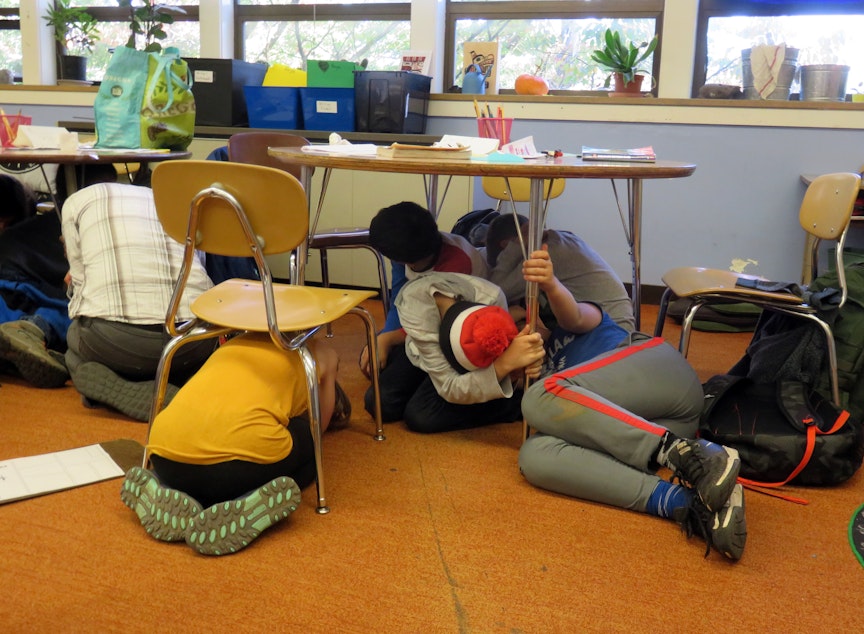Washington Legislature gets religion on earthquake retrofits for older school buildings

An effort to jump-start the pace of earthquake retrofits to vulnerable, older school buildings in Washington state has passed the Legislature unanimously. The Evergreen State has lagged behind other West Coast states and provinces in reinforcing schools to withstand strong shaking.
A report from the Washington State Department of Natural Resources last year said tens of thousands of Washington students attend class in buildings at high risk of collapse in an earthquake. Thousands more youngsters go to low-lying schools in the coastal tsunami zone.
Stanwood, Washington parent and PTA volunteer DaleAnn Baker was among a corps of citizen activists who successfully lobbied the Legislature to more than double state spending for earthquake retrofits, or in some cases, to pay most of the cost to relocate a public school out of the tsunami zone.
"The amount of funding is significant and this is great,” Baker said in an interview Wednesday. “It is really showing that the Legislature wants to make a commitment to this effort."
Baker said her journey into activism began a few years ago when she realized the elementary school where she sends her two children was built in 1956, long before modern seismic safety codes. “How is it acceptable to require kids to attend school in a building that may collapse during an earthquake?” the aerospace engineer asked herself and others.
Sponsored
On Wednesday, the Washington Senate voted 49-0 to pass a supplemental state construction budget that includes $100 million for earthquake and tsunami safety upgrades to the most vulnerable schools statewide. The action to send the budget bill to the governor’s desk followed a similarly lopsided 98-0 state House vote on Tuesday. The new funding for school seismic safety retrofits represents a 150% increase over last year’s level and a nearly eight-fold increase from just three years ago.
The Oregon Legislature way back in 2005 created a school seismic retrofit grant program on the scale now being launched from Olympia. The provincial government of British Columbia started a seismic mitigation program for schools in 2004 and has shelled out more than $1.9 billion for that since then.
Baker said a challenge ahead is to convince future Legislatures to maintain Washington state’s funding at about $100 million every two years.
“It will take a while to do this,” Baker noted. “It is going to take 10, 15, 20 years to properly do seismic updates to all of our school buildings in our state.”
Earlier this year, a bipartisan group of Washington senators proposed a statewide voter referendum to authorize a $500 million bond sale to pay for school seismic retrofits over the next decade. But by late February, a lead budget writer, Seattle Democrat David Frockt, said the earthquake safety spending could fit into the regular school construction budget, which eliminated an unnecessary risk of a bond measure failure.
Sponsored
Frockt said the money for this purpose now will come from regular state borrowing, which is repaid with general tax collections in the future.
"Providing safe places for children to learn is one of the state’s most serious responsibilities," Frockt said in a statement Wednesday. "The risk of an earthquake or tsunami may seem small at any particular place and time, but multiplied by all the communities in potentially geologically active areas across our state, this problem is urgent."
Frockt was the lead sponsor this winter on a separate school seismic safety policy bill, which establishes how Washington schools are prioritized for seismic retrofit funding and how much of the cost the state will shoulder. Qualifying K-12 schools must have been built before 1998. Local school districts can count on state and federal funding to cover at least two-thirds of an earthquake safety project’s cost.
Other people and groups that got involved in pressing the legislature for bold action this year included the Washington State PTA, Northwest Progressive Institute, various school district superintendents and a persistent former state representative from the Olympic Peninsula named Jim Buck.
"This is a good first step," Buck said by email after the state construction budget’s final passage Wednesday. "Let's make sure every mom and pop in the state understands it is now their job to hold their electeds responsible for fixing these schools." [Copyright 2022 Northwest News Network]

